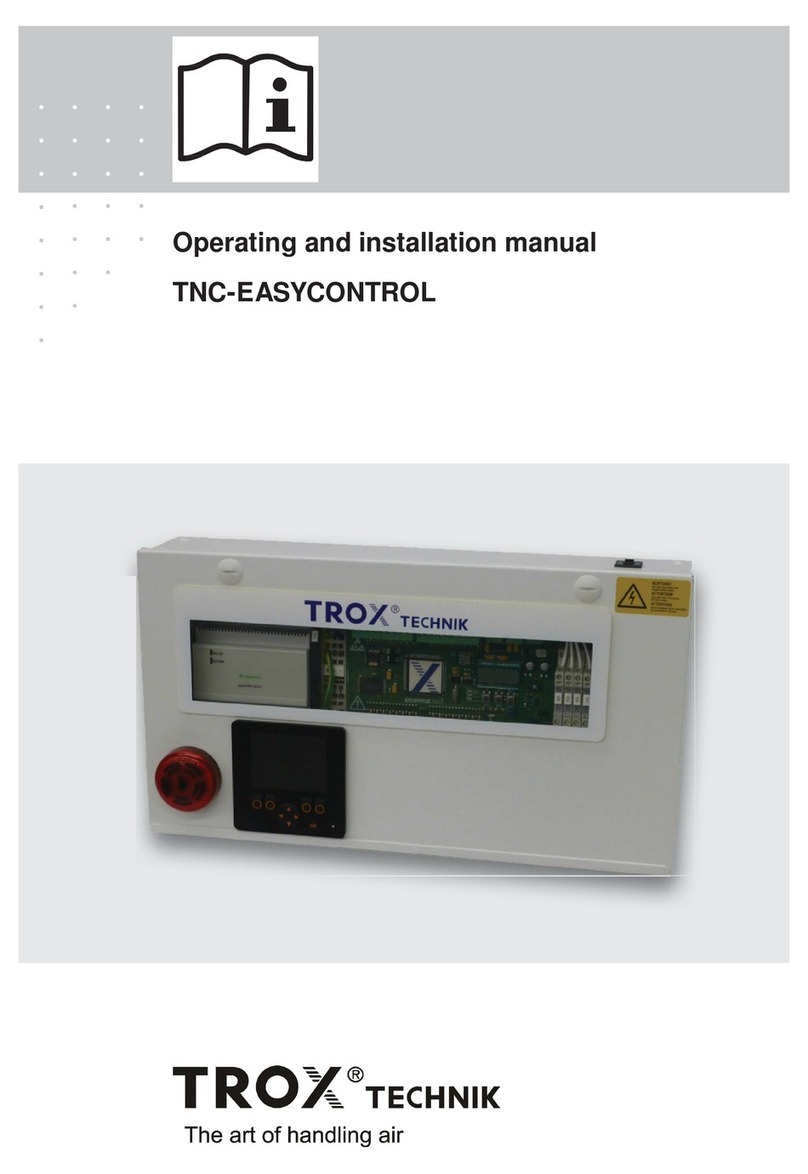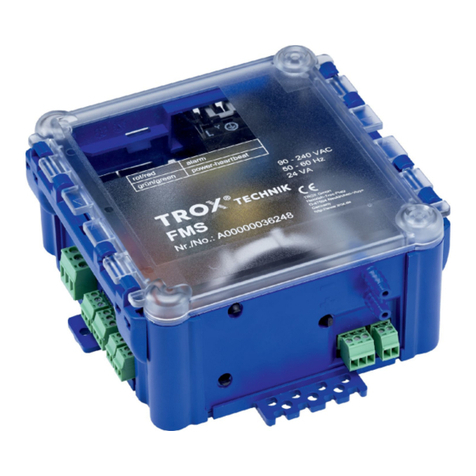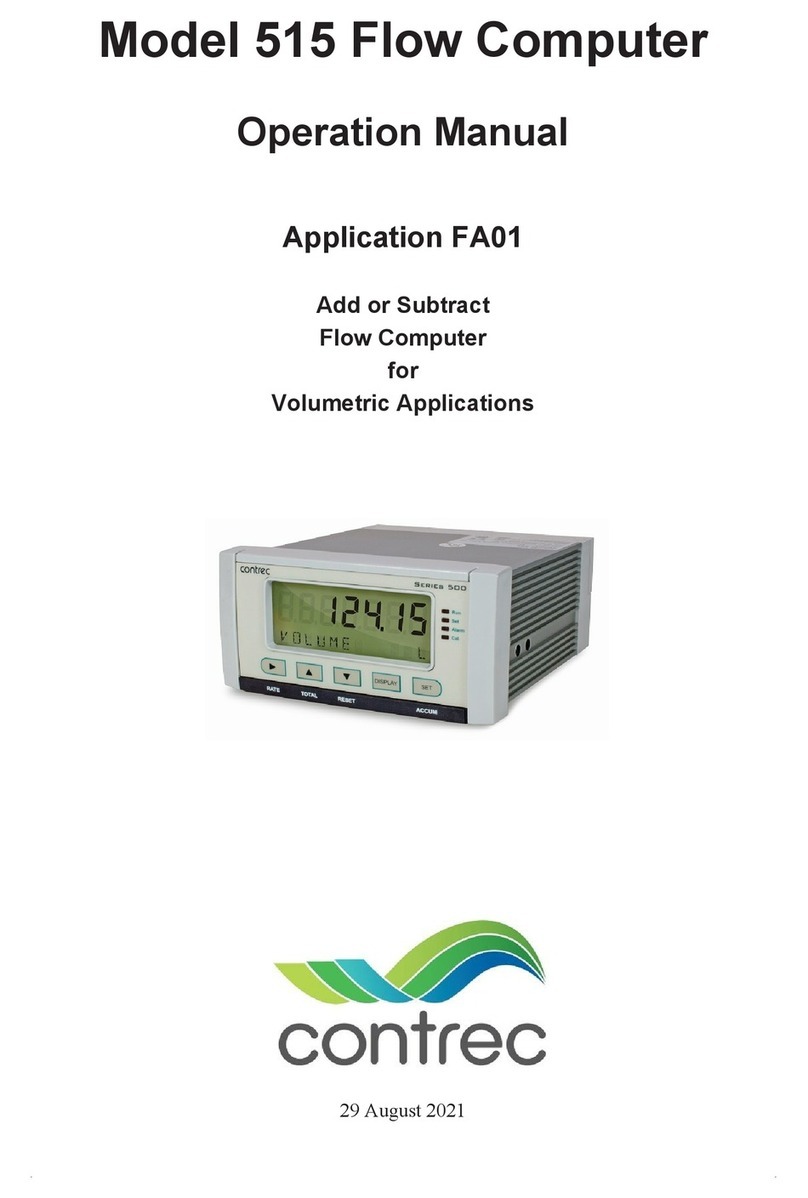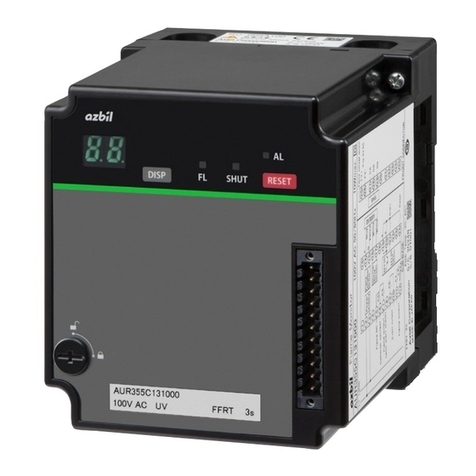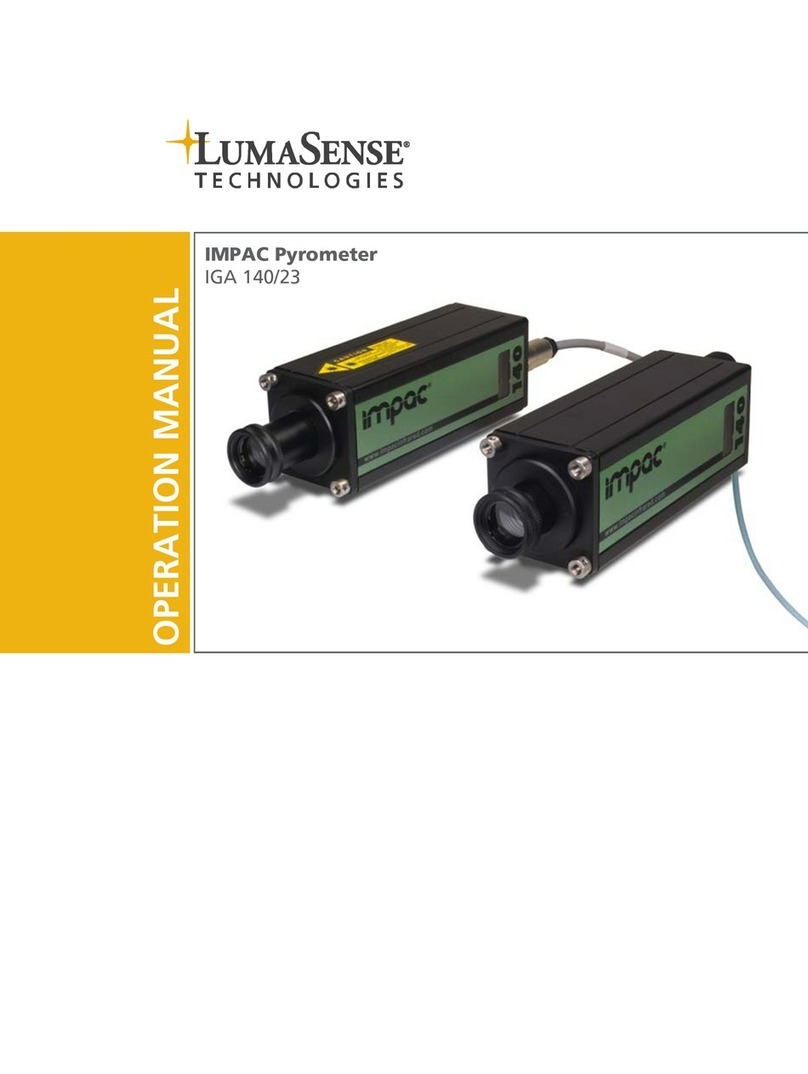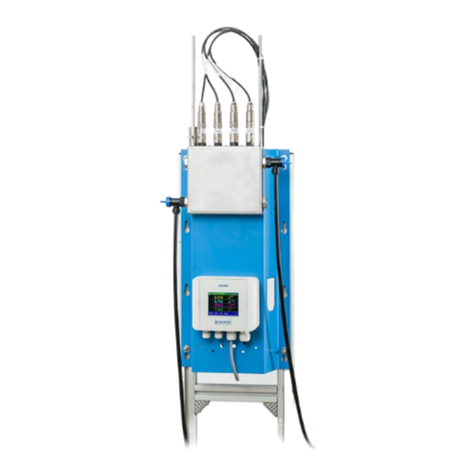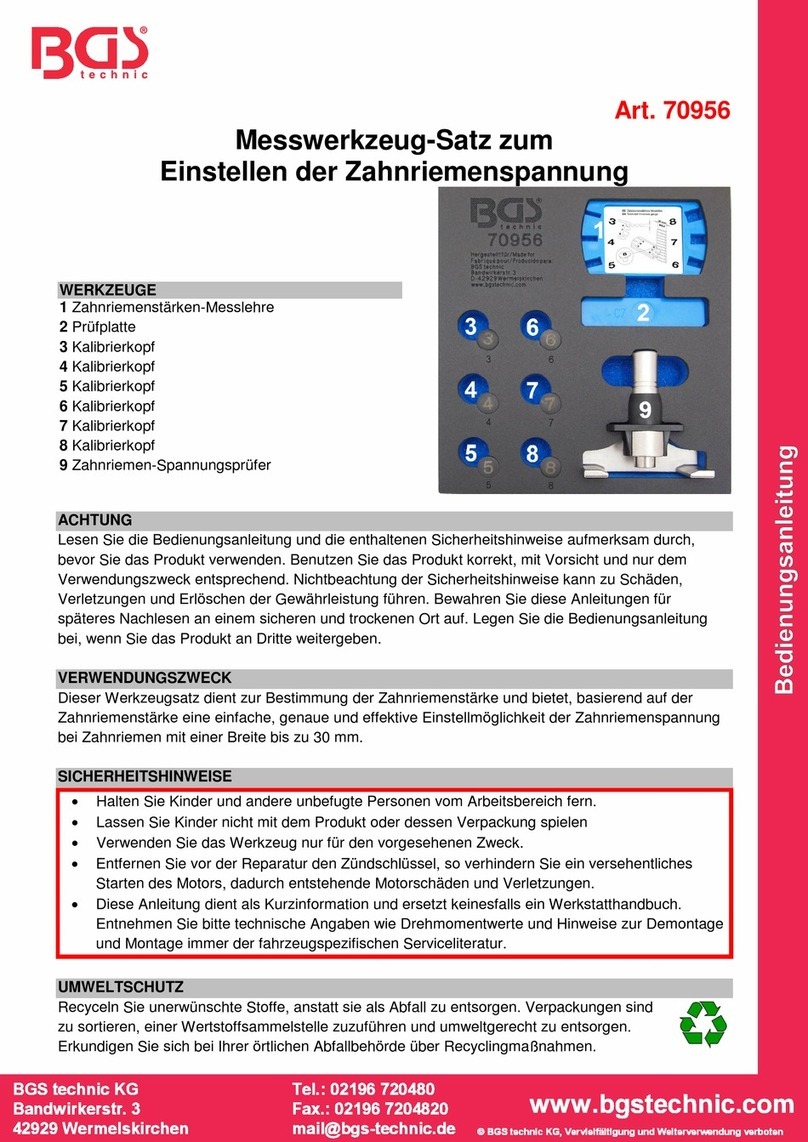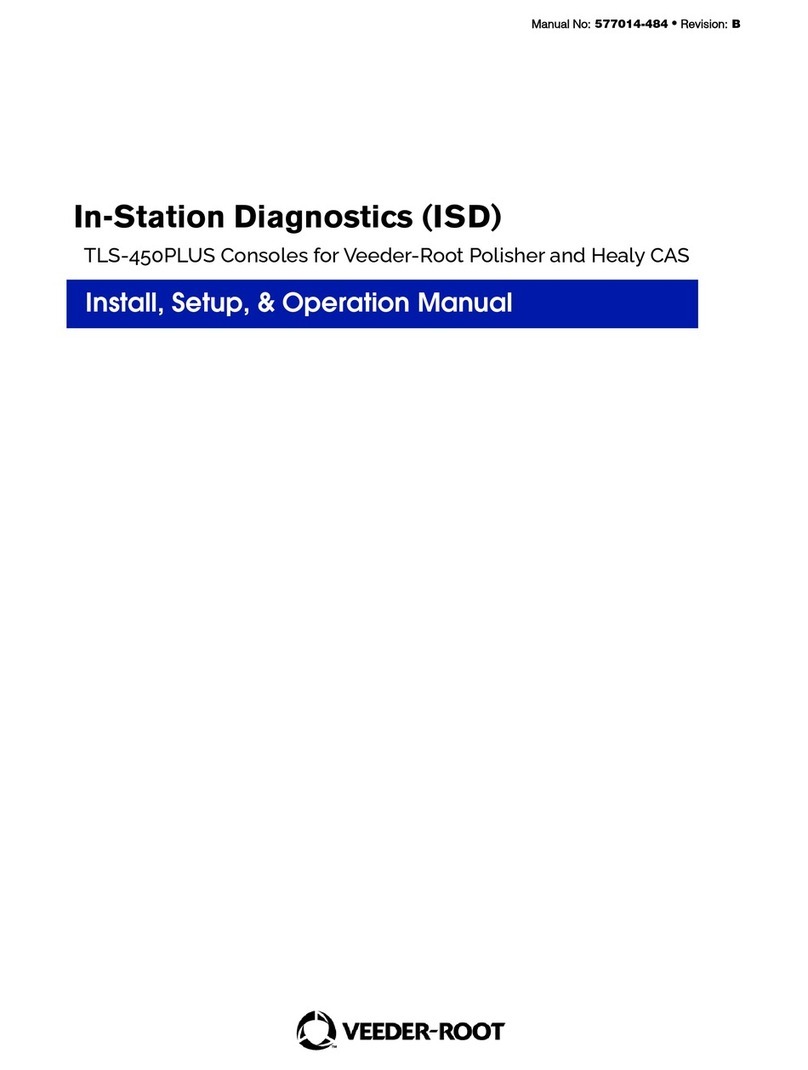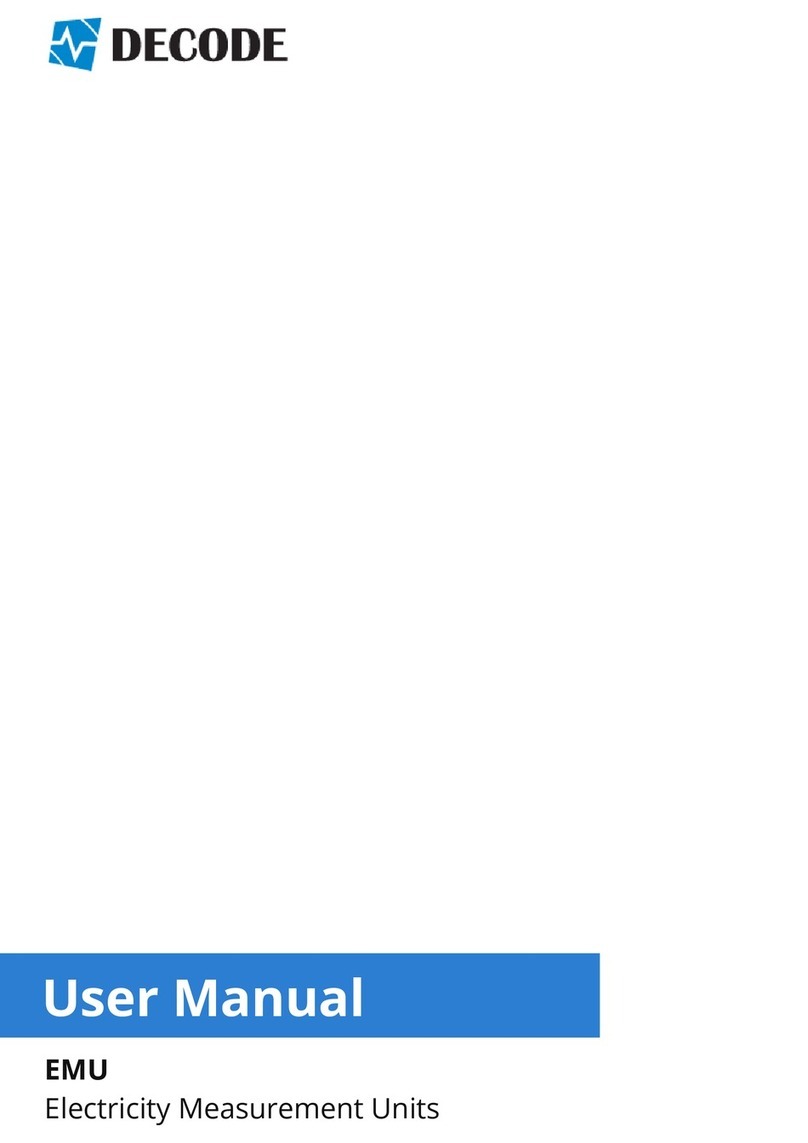Trox Technik CAV controllers User manual

Product overview
Fig. 1: Air terminal unit type EN
1 Damper blade
2 Bellows
3 Bellows inlet
4 Scales sticker
5Display damper blade position ðFig. 2
6 Hand wheel
7 Vmin-/Vmax actuator (optional)
Damper blade position display
The display is used to evaluate the throttle position
of the damper blade, e.g. in order to optimise the
control of the fan or the section regulation.
Attention: The display must not be adjusted.
Fig. 2: Display of the damper blade position
1 Damper blade in maximum throttle position -
Reduce system pressure
2 Damper blade in open position - System pres-
sure too low
Vmin-/Vmax actuator (optional)
Fig. 3: Vmin-/Vmax actuator
1 Vmax potentiometer
2 'Test' push button
3 Vmin potentiometer
4 LED status display
LED status display:
LED lit - Set position reached
LED flashes once per
second
- Actuator moves
LED flashes twice per
second
- Actuator blocks
LED off - No supply voltage
Functional test actuator
Press the test push button (> 2 s)
ðActuator turns toward Vmin
Actuator turns toward Vmax
Actuator returns to starting position
Installation manual GB/en
CAV controllers
EN
TROX GmbH
Heinrich-Trox-Platz
47504 Neukirchen-Vluyn
Germany
Phone: +49 (0) 2845 2020
Fax: +49 (0) 2845 202265
E-mail: [email protected]
http://www.troxtechnik.com
A00000075031, 12/2019, © 2017 TROX GmbH
CAV controllers EN 1

Important notes
Information on the installation manual
This manual enables operating or service personnel
to correctly install the product described below and
to use it safely and efficiently.
It is essential that these individuals read and fully
understand this manual before starting any work.
The basic prerequisite for safe working is to comply
with the safety notes and all instructions in this
manual.
The local regulations for health and safety at work
and general safety regulations also apply.
Correct use
CAV controllers of the type EN are used for con-
stant volume flow control in supply and extract air
ducts of ventilation and ventilation systems.
Do not use CAV controllers in extract air systems in
commercial kitchens unless the extract air has been
cleaned as much as possible with high-efficiency
aerosol separators; see VDI 2052.
The installation of air terminal devices in humid
rooms, areas with potentially explosive atmos-
pheres or rooms with dust-laden or aggressive air
has to be assessed for each individual case.
TROX Technical Service
To ensure that your request is processed as quickly
as possible, please keep the following information
ready:
Product name
TROX order number
Delivery date
Brief description of the fault
Online www.troxtechnik.com
Phone +49 2845 202-400
Qualified staff
HVAC technician
HVAC technicians are individuals who have suffi-
cient professional or technical training in the field
they are working in to enable them to carry out their
assigned duties at the level of responsibility allo-
cated to them and in compliance with the relevant
guidelines, safety regulations and instructions.
HVAC technicians are individuals who have in-
depth knowledge and skills related to HVAC sys-
tems; they are also responsible for the professional
completion of the work under consideration.
HVAC technicians are individuals who have suffi-
cient professional or technical training, knowledge
and actual experience to enable them to work on
HVAC systems, understand any potential hazards
related to the work under consideration, and recog-
nise and avoid any risks involved.
Skilled qualified electrician
Skilled qualified electricians are individuals who
have sufficient professional or technical training,
knowledge and actual experience to enable them to
work on electrical systems, understand any poten-
tial hazards related to the work under consideration,
and recognise and avoid any risks involved.
Personal protective equipment
Personal protective equipment must be worn for
any work in order to reduce health or safety haz-
ards to the minimum.
The appropriate protective equipment for a job must
be worn for as long as the job takes.
Industrial safety helmet
Industrial safety helmets protect the head from
falling objects, suspended loads, and the effects of
striking the head against stationary objects.
Important notes
CAV controllers EN2

Protective gloves
Protective gloves protect hands from friction, abra-
sions, punctures, deep cuts, and direct contact with
hot surfaces.
Safety shoes
Safety shoes protect the feet against crushing,
falling parts, and slipping on slippery ground.
Limitation of liability
The information in this manual has been compiled
with reference to the applicable standards and
guidelines, the state of the art, and our expertise
and experience of many years.
The manufacturer does not accept any liability for
damages resulting from:
Non-compliance with this manual
Incorrect use
Operation or handling by untrained individuals
Unauthorised modifications
The actual scope of delivery may differ from the
information in this manual for special constructions,
additional order options or as a result of recent
technical changes.
Transport and storage
Delivery check
Upon delivery, carefully remove the packaging and
check the unit for transport damage and complete-
ness. In case of any damage or an incomplete ship-
ment, contact the shipping company and your sup-
plier immediately. Put the product back into its
packaging after the delivery check to protect it from
dust and contamination.
Fixing and installation material
Fixing and installation material is not part of the
supply package (unless stated otherwise), but
has to be provided by others; it has to be suitable
for the installation situation.
Transport on site
CAUTION!
Danger of injury from sharp edges, sharp cor-
ners and thin sheet metal parts!
Sharp edges, sharp corners and thin sheet metal
parts may cause cuts or grazes.
– Be careful when carrying out any work.
– Wear protective gloves, safety shoes and a
hard hat.
Please note:
Be careful when unloading or moving the
product, and pay attention to the symbols and
information on the packaging.
If possible, take the product in its transport
packaging up to the installation location.
Use only lifting and transport gear designed for
the required load.
Always secure the load against tipping and
falling.
Transport and storage
CAV controllers EN 3

Do not move bulky items just by yourself. Get
help to prevent injuries and damage.
Only lift or hold the control unit at the housing,
not at the damper blade, at the flow rate
adjustment or at the actuator.
Storage
Please note:
Store the product only in its original packaging
Protect the product from the effects of weather
Protect the product from humidity, dust and
contamination
Storage temperature: -10 °C to 50 °C.
Relative humidity: 95% max., no condensation
Packaging
Properly dispose of packaging material.
Technical data
Nominal sizes 200 × 100 to 600 × 600 mm
Volume flow rate range 39 – 3500 l/s or 140 –
12600 m³/h
Volume flow rate control
range
Approx. 25 to 100% of the
nominal volume flow rate
Scale accuracy ± 4%
Minimum differential pres-
sure
50 Pa
Maximum differential pres-
sure
1000 Pa
Operating temperature 10 – 50 °C
Technical data actuator
Actuator E01 E02 E03
Supply voltage 24 V
AC/DC
230 V
AC/DC
24 V
AC/DC
Mains frequency AC: 50/60 Hz
Power rating DC: 2.5 W; AC: 4.5 VA
Protection level IP42
IEC protection
class
III II III
Setpoint value
signal input
– – 0 – 10 V
DC, Ra >
100 kΩ
Actual value
signal output
– – 0 –
10 V DC,
max. 0.5 m
A
Ambient temper-
ature
10-50 °C
Ambient humidity 5-90% rF
Technical data
CAV controllers EN4

Dimensions and weight
Fig. 4: EN
Product specific data EN
NG B H B1B2H1H2kg
200 × 100 200 100 230 260 130 160 4
300 × 100 300 100 330 360 130 160 5
300 × 150 300 150 330 360 180 210 6
300 × 200 300 200 330 360 230 260 6
400 × 200 400 200 430 460 230 260 7
400 × 250 400 250 430 460 280 310 8
400 × 300 400 300 430 460 330 360 8.5
400 × 400 400 400 430 460 430 460 13
500 × 200 500 200 530 560 230 260 8.5
500 × 250 500 250 530 560 280 310 9
500 × 300 500 300 530 560 330 360 9.5
500 × 400 500 400 530 560 430 460 14.5
500 × 500 500 500 530 560 530 560 15.5
600 × 200 600 200 630 660 230 260 10
600 × 250 600 250 630 660 280 310 10.5
600 × 300 600 300 630 660 330 360 11.5
600 × 400 600 400 630 660 430 460 17
600 × 500 600 500 630 660 530 560 18
600 × 600 600 600 630 660 630 660 20
Technical data
CAV controllers EN 5

Fig. 5: EN-D (with acoustic cladding)
Product specific data EN-D
NG B H B1B2H1H2kg
200 × 100 200 100 230 260 130 160 6.5
300 × 100 300 100 330 360 130 160 8
300 × 150 300 150 330 360 180 210 9
300 × 200 300 200 330 360 230 260 10
400 × 200 400 200 430 460 230 260 12
400 × 250 400 250 430 460 280 310 13
400 × 300 400 300 430 460 330 360 14
400 × 400 400 400 430 460 430 460 18
500 × 200 500 200 530 560 230 260 14
500 × 250 500 250 530 560 280 310 14.5
500 × 300 500 300 530 560 330 360 15.5
500 × 400 500 400 530 560 430 460 20.5
500 × 500 500 500 530 560 530 560 22
600 × 200 600 200 630 660 230 260 15.5
600 × 250 600 250 630 660 280 310 16.5
600 × 300 600 300 630 660 330 360 18
600 × 400 600 400 630 660 430 460 23
600 × 500 600 500 630 660 530 560 25
600 × 600 600 600 630 660 630 660 27.5
Technical data
CAV controllers EN6

Installation
Installation orientation
Any installation orientation.
When installing in horizontal ducting, the operating
side (rotary knob) must be arranged laterally (right/
left) or below.
Observe airflow direction!
Upstream conditions
The volume flow rate accuracy of CAV controllers
applies to a straight upstream section of the duct.
Bends, junctions or a narrowing or widening of the
duct cause turbulence that may affect volume flow
rate measurement. Depending on the respective
installation situation, information on the straight duct
section upstream of the control unit must be
observed.
Duct connections, e.g. branches off the main duct,
must comply with EN 1505.
Horizontal duct Vertical duct
Bend Bend
Junction Junction
Free air intake only with a straight duct section of
1B upstream.
Attaching sealing tape
To achieve the tightness class of the ducting,
sealing tapes have to be installed between the
ducting and the controller at both sides of the
flange, e.g. self-adhesive sealing tape.
Ensure that the sealing tape (Fig. 6/1) is attached
flush with the flange.
Fig. 6: Attaching the sealing tape to the flange
Installation
CAV controllers EN 7

Installing the controller
Personnel:
HVAC technician
Protective equipment:
Industrial safety helmet
Protective gloves
Safety shoes
Before you install the product, take suitable precau-
tions to protect air distribution components from
contamination during installation (VDI 6022). If this
is not possible, at least cover the product or take
other precautions to protect it from contamination.
In this case you have to ensure that the product
cannot be started. Ensure that all components are
clean before you install them. If necessary, clean
them thoroughly. If you have to interrupt the installa-
tion procedure, protect all openings from the
ingress of dust or moisture.
For installation please note:
Fix the product only to load-bearing structural
elements.
Load suspension systems only with the weight
of the product. Adjacent components and con-
necting ducts must be supported separately.
Use only approved and adequately sized fixing
material (fixing material is not included in the
supply package).
For maintenance or adjustment work, the
device must be accessible after installation.
Important: If there is a risk that the controller
could be subject to mechanical impact during
operation, protect it accordingly; protection has
to be provided by others.
Be careful to not damage the controller accidentally:
Handle the unit with care.
Lift the unit only by lifting the entire casing.
Never lift the unit by the damper blade, rotary
knob or actuator.
Fig. 7: Installation example
1. Install suspension rods and bars (Fig. 7/4) at
the installation location, at a distance of
approx. L+100 mm.
2. Assemble the ducts (Fig. 7/3) and lead them
up to the installation location of the con-
troller.
3. Insert seals (Fig. 7/6) between the flanges
Ä
‘Attaching sealing tape’ on page 7 (on-
site).
Observe the air direction arrow (Fig. 7/2)
during installation.
4. Screw the controller (Fig. 7/1) together with
screws, washers and nuts M10 (Fig. 7/5).
For version with acoustic cladding (EN-D)
Screw connection (Fig. 7/5) with screws
and washers M8;
Insulate ducts up to the acoustic clad-
ding of the controller (on-site).
Installation
CAV controllers EN8

Wiring
DANGER!
Danger of electric shock! Do not touch any live
components! Electrical equipment carries a dan-
gerous electrical voltage.
– Only skilled qualified electricians are allowed
to work on the electrical system.
– Switch off the power supply before working
on any electrical equipment.
Installation instructions
For installation, the supply voltage and, if neces-
sary, signal lines, must be connected for electrical
actuators.
The connection is made according to the informa-
tion given on the actuators or connection diagrams
in this manual. These must be observed for project-
specific wiring diagrams. The voltage ranges and
the terminal connections specified on the actuators
must be observed!
Personnel:
Skilled qualified electrician
Please note during installation:
Legal and official regulations, in particular VDE
guidelines.
Consideration of the technical connection rules
(TCR) of the local network operators.
Wiring work for supply voltage and signal lines
on site.
The rating and manufacture of customer-side
connections and wiring must be carried out in
accordance with the recognised rules of elec-
trical engineering.
Observe wiring guidelines and project-specific
circuit diagrams of the actuators.
The electrical connection to the actuator may
only be made if the installation has been car-
ried out correctly.
The 24 V supply voltage may only be supplied
with a safety transformer.
If several actuators are connected to a 24 V
mains supply, it must be ensured that a
common zero or ground line is defined and not
interchanged.
The actuator contains no parts that can be
replaced or repaired by the user and may only
be opened by the manufacturer.
Lay connecting cables in such a way that they
cannot be accidentally damaged by mechan-
ical impact or by heat.
Terminals for 0.5 – 2.5 mm², cables, rigid and
flexible, AWG 22–10
Strain relief
Devices that are permanently installed in buildings
are stationary electrical equipment for which no
strain relief on the connecting cables is prescribed.
Connection diagram Vmin / Vmax switching
E01, E02
Fig. 8: Connection diagrams actuator E01, E02
1 1-wire control
2 3-point control
S1 S2 Function
– Pos. 0 Actuator has stopped (undefined posi-
tion)
open Pos. 2 Vmin
Closed Pos. 3 Vmax
Wiring
CAV controllers EN 9

Colour assignment of the connecting cables
E01, E02
Pos. Colour Connection AC DC
1 BU Supply N GND
2 BN Supply L +
3 BK Switch input L +
Connection diagram variable volume flow E03
Fig. 9: Constant control input signal E03
1 Room temperature controller
2 Actual value output (value to be set)
Colour assignment of the connecting cables
E03
Pos. Colour Connection AC DC
1 BU Supply N GND
2 BN Supply L +
3 BK Signal w
4 GY Signal U
Room temperature control Fig. 9
A suitable room temperature controller or a DDC
outstation with 0-10 VDC output 2-wire (terminals 1
and 3) connected. With a common supply voltage of
24 V, note that terminal 1 is also ground for the con-
trol signal.
Override control: With 24 VDC at terminal 3, the
volume flow rate set at the Vmax potentiometer is
started.
Initial commissioning
Before you start commissioning:
Ensure that the device or unit has been cor-
rectly fixed and connected to the ducting.
Ensure that the devices or units as well as the
ventilation system are clean and that there are
no residual matter and foreign objects.
Important: If there is a risk that the controller
could be subject to mechanical impact during
operation, protect it accordingly; protection has
to be provided by others.
For commissioning see also VDI 6022, part 1 – 'Hy-
giene requirements for ventilation and air-condi-
tioning systems and units'.
Volume flow rate setting ranges
Nominal size [l/s] (m³/h)
min max min max
200 × 100 39 164 140 590
300 × 100 65 260 234 936
300 × 150 82 460 295 1656
300 × 200 120 515 432 1854
400 × 200 200 875 720 3150
500 × 200 180 900 648 3240
600 × 200 225 1010 810 3636
400 × 250 200 885 720 3186
500 × 250 235 1190 846 4284
600 × 250 300 1310 1080 4716
400 × 300 310 1280 1116 4608
500 × 300 365 1580 1314 5688
600 × 300 350 1750 1260 6300
400 × 400 400 1750 1440 6300
500 × 400 360 1800 1296 6480
600 × 400 450 2020 1620 7272
500 × 500 470 2380 1692 8568
600 × 500 600 2620 2160 9432
600 × 600 700 3500 2520 12600
Initial commissioning
CAV controllers EN10

Setting the volume flow rate
Sufficient duct pressure must be ensured for all
operating conditions and for all control units. The
measurement points for fan speed control must be
selected accordingly.
Fig. 10: Setting the volume flow rate
1. Using the volume flow rate scale (Fig. 10/1),
determine the setting value (1-10) for the
desired volume flow rate (l/s, m³/h, or cfm).
2. Loosen the hexagon socket screw
(Fig. 10/3).
3. Set the rotary knob to the determined value
of the setting scale (Fig. 10/2) and fix it with
the hexagon socket screw (Fig. 10/3).
No further measurement or adjustment is
necessary.
Setting Vmin/Vmax actuators
Fig. 11: Setting the volume flow rate
Factory setting:
Vmin: 4
Vmax: 8
1. Using the volume flow rate scale (Fig. 11/1),
determine the setting value (1-10) for the
desired volume flow rate (l/s, m³/h, or cfm).
2. Set the desired value at the Vmin potentiom-
eter (Fig. 11/3).
3. Set the desired value at the Vmax potenti-
ometer (Fig. 11/2).
4. Carry out a functional test using the test
push button and check the scale position
reached for the preset volume flow after the
motorised adjustment process.
Initial commissioning
CAV controllers EN 11

Example for actuator E01, E02:
Given data:
EN 300x200
– Vmin 432 m³/h
– Vmax 1854 m³/h
Volume flow rate night-time operation 800
m³/h
Volume flow rate day-time operation 1600
m³/h
Settings according to scale Fig. 11:
Vmin potentiometer: 4.5
Vmax potentiometer: 9
Characteristics E03
Fig. 12: Characteristics of the control signal
1 Scale setting
2 Setpoint value w
Vmin: 0 V ð scale setting 4.5
Vmax: 10 V ð scale setting 9
Fig. 13: Characteristic actual value signal
1 Scale setting
2 Actual value U
Vmin: 4.5 V
Vmax: 9 V
Actual value signal
The actual value signal of actuator variant E03
corresponds to the current actuator position in
the scale range and is not a measure of the
actual volume flow rate, since the CAV controller
does not measure the volume flow rate but only
controls it using the aerodynamic forces.
Initial commissioning
CAV controllers EN12

Maintenance and cleaning
Maintenance
It is the system owner's duty to set up a mainte-
nance schedule, taking the actual operating condi-
tions (contamination, operating time etc.) of the
ventilation system into consideration.
Important: Do not lubricate the bearings of the
damper blade.
Maintenance jobs to be carried out regularly:
Visually check the controller for contamination,
damage and corrosion. Remove contamina-
tion; if the controller has been damaged, or if
there is any corrosion, replace the controller.
Check the fixing of the controller and of the
connected ductwork.
Replacement parts and retrofit
Incorrect replacement parts
WARNING!
Risk of injury from the use of incorrect
replacement parts!
Incorrect or faulty replacement parts pose a risk
to health and safety, and their use can cause
malfunction, damage to property and total failure
of equipment.
– Use only original replacement parts from
TROX.
Retrofit of electric actuator
The EN controller can easily be retrofitted with an
electric actuator.
Order code for retrofit kits:
NR-VAV-EN-E01 24 V AC / DC actuator min / max
switching
NR-VAV-EN-E02 230 V AC / DC actuator min / max
switching
NR-VAV-EN-E03 24 V AC / DC constant actuator for
variable operation
Cleaning
Please note:
The cleaning intervals given in the VDI 6022
standard apply.
Clean surfaces with a damp cloth.
Use only common household cleaners, do not
use any aggressive cleaning agents.
Do not use cleaning agents that contain
chlorine.
Maintenance and cleaning
CAV controllers EN 13

CAV controllers EN14
This manual suits for next models
2
Table of contents
Other Trox Technik Measuring Instrument manuals
Popular Measuring Instrument manuals by other brands
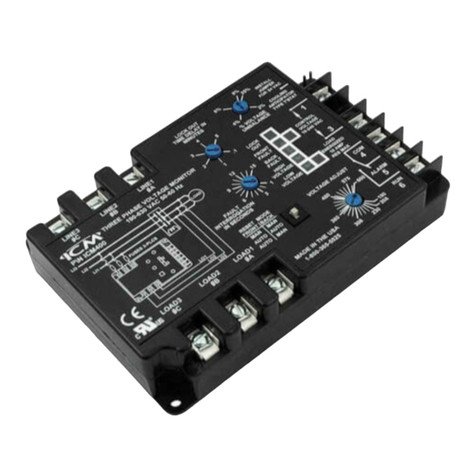
ICM Controls
ICM Controls ICM400 Installation, operation & application guide
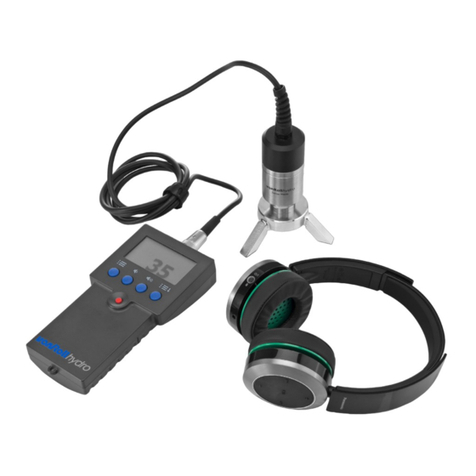
vonRoll hydro
vonRoll hydro TERRALOG operating instructions
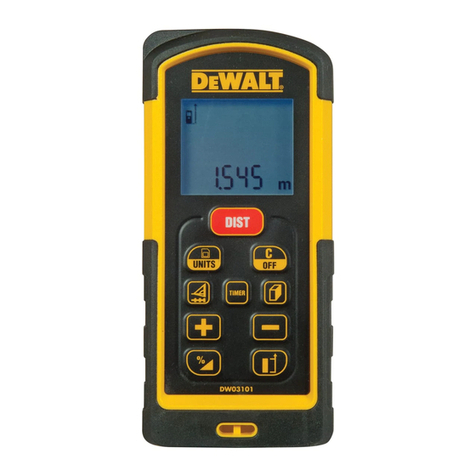
DeWalt
DeWalt DW03101 user manual
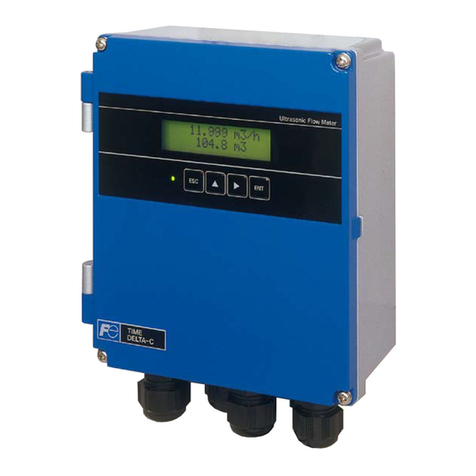
Fuji Electric
Fuji Electric Time Delta-C FSV-2 instruction manual

PMI
PMI Eagle 120 user manual
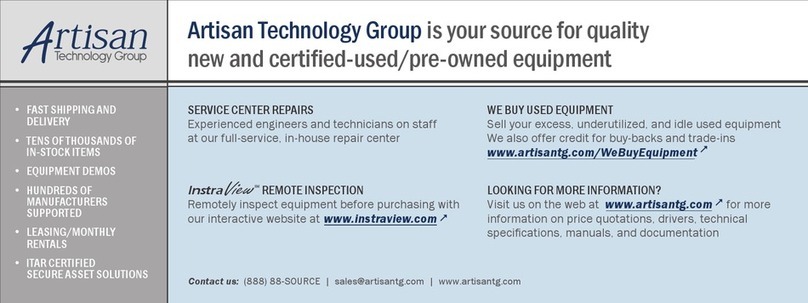
Agilent Technologies
Agilent Technologies 16712A Help Manual
